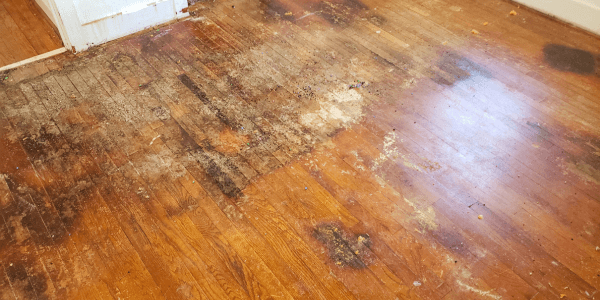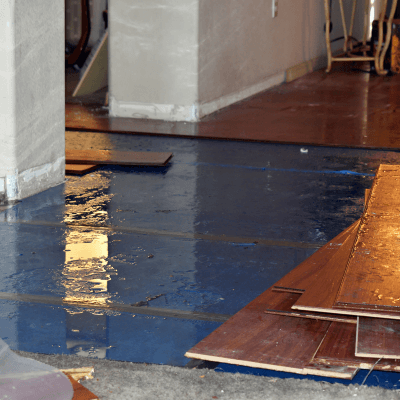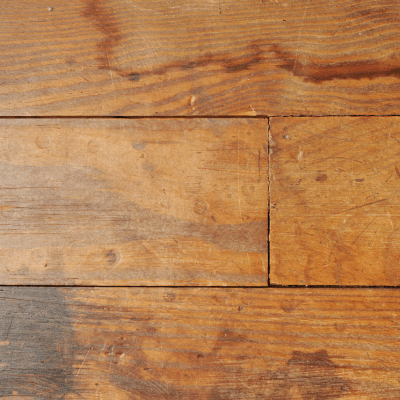
Signs of water damage on hardwood floors can often appear when you least expect them, turning your beautiful home into a costly repair project. One moment, your floors are shining bright; the next, they’re buckling and discolored. Early detection is crucial to avoid extensive repairs and save your wallet from a hefty hit.
Hardwood flooring is a favorite among homeowners in San Antonio for its timeless beauty and durability. However, as lovely as it is, water damage can turn your dream floors into a nightmare faster than you can say “flood.” It’s vital to be aware of those sneaky signs, as they can help you act quickly and prevent costly repairs down the road. So, let’s roll up our sleeves and dive into the world of hardwood floors, ensuring you can keep your home looking its best!
Recognizing the Red Flags: Common Signs of Water Damage on Hardwood Floors
When it comes to unwelcome water intrusion, recognizing it early can save you from seeing Signs of water damage on hardwood floors.
Here are some key red flags to watch for:
- Dark Spots or Stains: Dark patches on ceilings, walls, or floors indicate moisture buildup and possible water seepage, which can lead to mold growth.
- Warping or Buckling: Warping in floors, walls, or furniture signals excess moisture. If wood swells and bends, it could result in more extensive damage if not addressed promptly.
- Increased Humidity or Musty Smell: A sudden rise in humidity or musty odors often points to hidden water damage, especially in specific areas where leaks or stagnant water may be present.
- Peeling Paint or Wallpaper: Bubbling paint or peeling wallpaper suggests trapped moisture, possibly from a roof or plumbing leak that requires immediate attention.
Read more: Spot the Signs of Drywall Water Damage Like a Pro.
The Science of Wood Flooring: How Long Does It Take for Water to Damage Wood Floors?
Understanding how long it takes for water to damage your hardwood floors can be eye-opening. Water doesn’t wait for a convenient moment; it can start affecting your beautiful floors almost immediately.

Timeframe for Visible Damage: Typically, you might start to see signs of water damage within just a few hours of exposure. However, the full extent of the damage may not be apparent until days or even weeks later, depending on several factors. This is why it’s crucial to act quickly if you notice any leaks or spills.
Factors Influencing Damage Speed:
- Type of Wood: Different hardwoods react to moisture in various ways. Softer woods tend to absorb water more quickly and can show signs of damage sooner than harder woods.
- Moisture Level: The amount of water present plays a significant role. A small spill may cause minimal damage, while extensive flooding can lead to rapid deterioration.
Stages of Damage:
- Initial Exposure: The wood begins to absorb moisture, and minor discoloration may occur.
- Visible Damage: After several hours to days, you may notice dark spots, swelling, or warping.
- Severe Damage: Left untreated for weeks, wood can develop serious structural issues, including mold growth and irreversible warping.
Humidity Levels: In a humid environment like San Antonio, wood floors are particularly vulnerable. High humidity can exacerbate water absorption, leading to quicker damage. Conversely, if the air is too dry, the wood may shrink and crack. Maintaining a balanced humidity level is vital to prolonging the life of your hardwood floors.
Learn more about managing indoor humidity levels from the EPA.
Assessing the Damage: Key Indicators to Inspect
Once you’ve spotted signs of water damage, it’s time to assess how deep the problem runs—especially when it comes to your hardwood floors. Here’s how to conduct a thorough evaluation to keep your home safe:
- Under Carpets: Water can sneak beneath rugs, so lift them up and check for dampness or discoloration on the hardwood below.
- Near Baseboards: Moisture often collects around baseboards, so look for swelling or peeling paint that could indicate water intrusion.
- Behind Furniture: Move furniture away from walls and floors to uncover hidden damage. You might find issues lurking behind couches or cabinets that are easy to miss.
Routine inspections can help you catch water damage early. We recommend checking your home at least once a season, or more frequently if you’ve had recent storms or plumbing work done. For more tips on disaster preparedness and home inspections, visit FEMA’s website.
Steps for a Thorough Inspection:
- Visual Examination: Examine your hardwood floors for warping, buckling, or discoloration around joints and seams. Pay attention to dark spots that may indicate underlying moisture.
- Feel for Moisture: Run your hand along the edges of the boards and visible cracks. If they feel damp or spongy, the water damage may be more extensive than it seems.
- Check for Odors: A musty smell signals potential mold growth. If you notice any unpleasant odors, investigate further for hidden moisture issues.
- Use a Moisture Meter: If you have one, a moisture meter accurately measures moisture levels in your wood floors, helping determine if they are excessively saturated and require immediate attention.
- Identify Affected Areas: Note all spots showing signs of water damage and areas where water may have pooled. This information will be crucial when consulting with restoration professionals.
Remember, acting swiftly can prevent more extensive damage and save you money in the long run!
Understanding Repair Costs: Wood Floor Water Damage Repair Cost
Now that you’ve assessed the damage to your hardwood floors, you may be feeling a mix of concern and urgency. The next step in your journey is understanding what it will take to restore your home and, more importantly, what it might cost you. It’s completely normal to feel anxious about repair expenses, especially when it comes to water damage, which can lead to significant financial implications if not addressed promptly.
Average Repair Costs for Water Damage
When it comes to water damage repair costs, the figures can vary widely based on several factors. On average, homeowners might expect to pay anywhere from $1,000 to $5,000 for repairs, but this can increase depending on the extent of the damage. For example, minor repairs may cost around $500, while extensive damage requiring full replacement of hardwood floors can run upwards of $10,000.
Factors Influencing Repair Costs

Several factors play a role in determining the final cost of repairs:
- Extent of Damage: The more severe the damage, the higher the repair costs. If your floors are warped and require replacement rather than just repair, you’ll face a steeper bill.
- Type of Repair Needed: Different repair methods come with varying price tags. Simple fixes like refinishing might be less expensive than replacing entire sections of flooring.
Read more: Hidden Water Damage Costs in San Antonio.
DIY vs. Professional Repair Costs
- DIY Repairs: Tackling repairs on your own can save you money upfront, but beware—if the damage is extensive, you might end up spending more in the long run. Equipment rentals and materials add up quickly, and without the proper expertise, you risk making the situation worse.
- Professional Repairs: Hiring professionals ensures that the job is done right the first time, but this comes at a price. While you may pay more initially, professional repairs often save you from costly mistakes and future repairs.
Tips for Budgeting and Potential Hidden Costs
- Get Multiple Quotes: Reach out to several contractors to compare pricing and services. This gives you a clearer picture of what to expect.
- Plan for the Unexpected: Water damage can sometimes hide other issues. Set aside a contingency budget (around 10-15% of your total repair budget) for unforeseen costs that may arise during the repair process.
- Understand Your Insurance: Check with your homeowner’s insurance policy to see what water damage coverage you have. Knowing this in advance can help alleviate some financial stress.
Next Steps: Take Control of Your Home’s Health
Remember that being proactive is your best defense. Addressing potential issues early can save you from costly repairs and significant stress down the line. With a little vigilance, you can protect your beautiful hardwood floors and maintain the comfort of your home.
- Conduct a Thorough Inspection: Use the checklist we provided to assess your hardwood floors regularly. Look for any signs of damage, and don’t forget to check hidden areas.
- Take Action Immediately: If you notice any red flags—like dark spots or warping—don’t wait. The sooner you act, the less damage you’ll face.
- Consult with Professionals: If you find concerning signs or if the damage seems extensive, reach out to experts. We at Complete Flood Restoration are ready to provide you with an assessment and guide you through the repair process.
By staying vigilant and acting swiftly, you can protect your home and enjoy peace of mind. If you suspect water damage in your hardwood floors, don’t hesitate to contact us at Complete Flood Restoration. Our team of IICRC certified professionals is dedicated to helping you restore your home efficiently and effectively. Call us today for a free consultation and take the first step toward safeguarding your investment!
For real-life examples of how we’ve handled similar situations, check out our Recent Projects.Or read more from our blog: Water Damage Cleanup: What You Can Do (and When to Call in the Pros).
